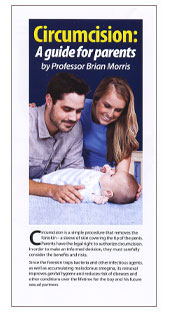Circumcision
Risks in Adults and Older Boys
Circumcision, while simple, is less so with age and thus growth in size of the penis. “Complications”, although low, are generally about 10-fold higher than in infancy. A study by CDC researchers of 1.4 million circumcisions found that compared to the 0.4% prevalence seen in infants, adverse events were 20-times more frequent in boys aged 1–9 years, and were 10-times higher for males aged ≥10 years [El Bcheraoui et al., 2014]. In a large California study in 2019, adverse events were 0.5% in neonates and 18.5 times higher in non-neonates [Hung et al., 2019].
In the Kenyan randomized controlled trial (RCT), 1.7% of the men had an adverse event. Of these, the most common were postoperative bleeding (0.4%) or infection (0.4%), followed by wound disruptions (0.3%), delayed healing (0.2%), and swelling at the incision site (0.1%) [Bailey et al., 2007; Krieger et al., 2007]. One man had an adverse reaction to an excess of the local anesthetic. In this trial, 96% of the men had returned to normal activities, including work, by day 3 following circumcision. At 3 days 48% reported no pain, 52% mild pain, and none had severe pain. By the 8 day visit 89% reported no pain and 11% mild pain. By 30 days the wound had healed completely in 99% and by 3 months 100%. By one month all had returned to normal activities.
In the South African RCT, 3.8% had an adverse event as follows: pain (0.8%), excessive bleeding (0.6%), infection (0.2%), swelling or hematoma (0.6%), problems with appearance (0.6%), damage to the penis (0.3%), insufficient skin removed (0.3%), delayed wound healing (0.1%), anesthesia-related event (0.06%) [Auvert et al., 2005]. At 21 months follow-up the following were seen in 1.0%: problem with urinating (0.3%), dissatisfaction with the appearance of the penis (0.4%), mild or moderate erectile dysfunction (0.4%).
In the Ugandan RCT the rate of moderate adverse events was 3% and severe 0.2% [Gray et al., 2007a], i.e., 1 event per 500 surgeries. The severe events included 1 wound infection, 2 hematomas that required re-exploration and ligation of bleeding vessels, one wound disruption due to an external cause, and one postoperative herpetic ulceration [Gray et al., 2007a]. All were managed successfully and they all resolved.
An average of 3.8% adverse events has been seen for the first 1–100 circumcisions a clinician does [Krieger et al., 2007]. For the next 100 this drops to 2.1% and by the time they have done 200–400 this drops to less than 1%. Beyond 400 it is 0.7%. In the RCT in Uganda the rate of moderate and severe adverse events was 8.8% for the first 19 unsupervised procedures after training, 4.0% for the next 20–99, and 2.0% for the last 100 [Kiggundu et al., 2009]. Time taken per patients was approx. 40 minutes for the first 100 and 25 minutes for the subsequent 100.
In boys up to age 15 in the UK, 1.5% experienced a complication [Cathcart et al., 2006]. These included hemorrhage (0.8%), infection (0.3%) and requirement to return to theatre (0.5%).
Wiswell and co-workers examined records of boys circumcised in US Army Hospitals after the neonatal period (mean age 2.9 years), in whom 93% was by ‘sleeve’ or ‘freehand’ resection under general anesthesia in 91% [Wiswell et al., 1993]. Eight of 476 experienced a complication, namely excessive bleeding (3; 0.6%), malignant hyperthermia (2; 0.4%), aspiration pneumonia (1; 0.2%), large hematoma (1; 0.2%) and postoperative fever (1; 0.2%).
For the Plastibell method, a study in Pakistan found the most common complication to be Plastibell impaction, managed by cutting the Plastibell [Samad et al., 2009]. Although rate was 2.3% of babies under 3 months the rate increased gradually for circumcision at older ages, reaching 26.9% for children over 5 years [Samad et al., 2009].
When circumcision is performed by traditional circumcisers in Africa as part of initiation into manhood high rates of complications and even deaths are seen. Even after operator training, incorrect instrument use occurred and complications remained unacceptably high [Peltzer et al., 2008]. In this study of the Xhosa in South Africa, 88% of the adolescents (mean age 18.7) had already started to have sex before being circumcised, putting them at risk. Other studies in Africa noted high complication rates for both medical and traditional groups, albeit at half the rate for the medical [Bailey et al., 2008a; Kim & Goldstein, 2009]. In another report, it was found that 7 days after circumcision by medical professionals following a one-day training workshop, there was insufficient skin removal in 5.5%, excessive skin removed in 1.3%, pain in 1.3%, infection in 1.3%, but no problems with excessive bleeding, swelling, hematoma, damage to the penis, problems urinating, dehydration or appearance [Peltzer & Kanta, 2009]. The findings offered promise for scaling up of medical circumcision alongside traditional initiation into manhood. Deficiencies in training and resources in settings such as Africa need to be addressed and new methods such as use of simple, safe devices [Kim & Goldstein, 2009].
In Turkey, circumcision of boys aged 1.5–14 (mean 7 years) by unlicensed traditional circumcisers led to a far greater number of complications (85%) compared with those performed by surgeons in a sterile hospital setting (2.6%). The boys who experienced complications were aged 2–13 (mean 6) [Atikeler et al., 2005]. For example, excessive bleeding (23% versus 1.2%), infection (14% versus 0.5%), hematoma (6% versus 0.2%).
The rate of complications for boys in Iran mostly operated on by traditional circumcisers was 7.4%, including excessive residual foreskin (3.6%), excessive skin removed (1.3%), meatal stenosis (0.9%), granaloma (0.7%), penile rotation (0.5%), secondary cordee (0.2%) [Yegane et al., 2006].
Circumcision of Muslim boys by medical personnel during circumcision festivities in the Comoros Islands was associated with a low (2.3%) complication rate, mostly infections (1.5%) [Ahmed, 2007].
Ritual circumcision was blamed for bleeding complications in a hospital emergency department in France [Bocquet et al., 2009].
A US study of patients diagnosed later in life with a bleeding disorder found overall incidence of bleeding after circumcision to be 23% [Rodriguez et al., 2009]. This occurred in some of them despite adequate clotting factor replacement.
Thus circumcision is quite a safe procedure, with a low rate of complications, most of which are immediately and easily treated. However, the rate of complications is 10 times higher in men and older children than in infants, making infancy the best time to circumcise for this and other reasons.
One should be aware that many men are incorrectly advised to “put up” with a problem caused by their foreskin rather than have a circumcision. Early elective surgery eliminates or greatly reduces the risk of getting such problems in the first place, and later circumcision will ensure they or other problems are avoided or reduced substantially.



